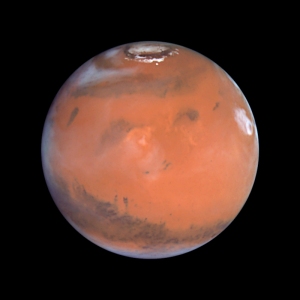Regarding the Earth’s equivalent Chandler wobble, Wikipedia says: ‘Since the Chandler wobble should die down in a matter of decades or centuries, there must be influences that continually re-excite it.’ Presumably the same will apply to Mars, but as relevant observations are all fairly recent no conclusion can be reached at present.
– – –
Spacecraft find that Mars oscillates 10 centimeters off its axis of rotation, says Eos.
In a first for a solar system body other than Earth, scientists have detected the Chandler wobble on Mars, a repeated movement of the poles on the surface of the planet away from its average axis of rotation.
The Chandler wobble arises when a rotating body isn’t a perfect sphere. This imbalance affects its spin.
The result is a wiggle resembling that of a swaying top as it loses speed, rather than the smooth spin of a perfectly balanced globe.
Measurements over nearly 2 decades by spacecraft orbiting Mars uncovered that on the surface, the planet’s poles wander up to 10 centimeters from the average axis of rotation, with a repeated cycle of about 207 days.
The new findings by Konopliv et al provide new insights into the interior of Mars.
The amount of time it takes for the pole to complete one cycle of the wobble reflects how much Mars’s mantle can deform, providing hints about its material properties and thermal state.
“[The Chandler wobble] is a very small signal, typically,” said Alex Konopliv, an aerospace engineer at NASA’s Jet Propulsion Laboratory in Pasadena, Calif. “You need many years and high-quality data to detect it,” he said.
A previous study, for example, didn’t have enough data points to differentiate the Chandler wobble from seasonal effects. Konopliv is the lead author of the new research, which was published in AGU’s Geophysical Research Letters.
The Chandler wobble is one of several off-center motions exhibited by Earth as it rotates on its axis. Earth’s Chandler wobble varies from 3 to 6 meters at the poles and has a pattern that repeats approximately every 433 days.
Although such motion should naturally dampen over time, on Earth it persists because of ocean bottom and atmospheric pressure fluctuations.
In the new study, researchers were able to confirm the movement on Mars by calculating gravitational effects on the orbits of two NASA spacecraft circling the Red Planet: Mars Odyssey and the Mars Reconnaissance Orbiter.
The large quantity of data, collected over 18 years and not available during earlier analyses, ensured that the identified wobble was intrinsic to the planet’s shape and interior, rather than outside factors like seasonal melting of polar ice caps.
Full article here.







In the paper: Precession and Nutations of Mars calculated with Kinoshita’s Model (IAU, 1997), Table 2 lists the Phobos (Martian moon) influence on Mars as having a period of 825.64 days.
825.64/4 = 206.41 days, within the quoted period of the Mars wobble i.e. 206.9 ± 0.5 days.
Phobos orbits 6,000 km (3,700 mi) from the Martian surface, closer to its primary body than any other known planetary moon
https://en.wikipedia.org/wiki/Phobos_(moon)
Planets are not perfect spheres and perfectly homogeneous. Besides they also change over time and both from intrinsic changes and under external influences.
This video -second half- show the earth from a gravitational perspective. https://www.youtube.com/watch?v=5CdlOKpJUyQ
Chandler wobbles are not the same thing as precession of the planet’s axis.
https://en.wikipedia.org/wiki/Axial_precession
CW = ~433 days
Axial p. = ~25,800 years
[…] First detection of a built-in wobble on another planet – Mars […]
Re Chandler wobble https://link.springer.com/article/10.5047/eps.2010.11.002
OB suggests: “Axial p. = ~25,800 years”
Recently I looked at a list I shelved from Seidelmann (1992) for later study. There are always enough interesting things to explore to last several lifetimes. As I suspected the list (which was mislabeled in the publication – a typo) produced a bunch of really easy hits. It’s easy to differentiate ~25685, ~25760, & ~25810. There’s no need to settle on 1. They each represent something different and they’re all part of the same bundle.
This stuff is simple enough that it is likely well-understood quite easily by a rather large number of people knowledgeable about astronomy. Progress is swift in the few sittings I’ve had time for. Probably an amateur could do a complete decode of the frame if they had sufficient freedom for the endeavor. My pilot exploration suggests there is a trivial decode for the entire system, spanning across all scales including Chandler & solar rotation. I can’t make it a priority to finish the work and share in digestible form, but I will share something simple and easy-to-understand on the 64000 year cycle (known to Mayan sages).
I’d never heard of that cycle. I was just doing initial probes on simple raw intuition — and there it was. An internet search made it clear it has long been known.
64000
RR Newton in a 1972 paper discusses other behaviour of earth dynamics.
Link http://adsabs.harvard.edu/full/1972Ap%26SS..16..179N
or http://www.pereplet.ru/gorm/atext/Newton1.htm (easier to notate).
Changes (in fig 4, 5) seem to align with 1/2 Eddy cycle.
Section 6 makes for interesting reading. It looks evident we have been quick to blame the ancients’ measurements to inaccuracy for disagreement with the later formulae. But never blame the later inaccurate curve fitting. (Apart from Ptolemy’s fudging).
Earth is spinning faster than it has for 50 years (and we might have to ‘subtract’ a second)
Tue, January 5, 2021
Earth is spinning unusually quickly – and last year saw the shortest day since people started counting.
In fact, 2020 saw the 28 shortest days since 1960, beating the previous shortest day in 2005, according to TimeandDate.com.
https://news.yahoo.com/earth-spinning-faster-171357980.html
There are a few other ways to get 64000. I’ve shared 1 more along with 260.
Reblogged this on Gwynedd Blog.